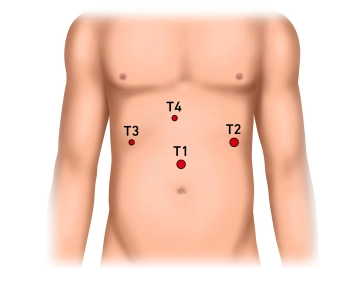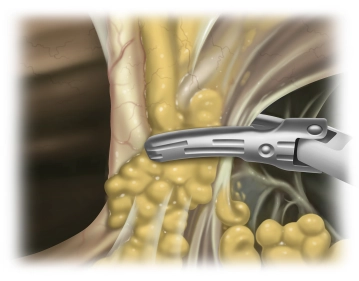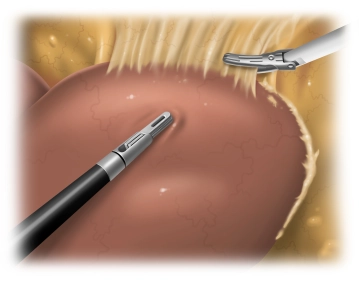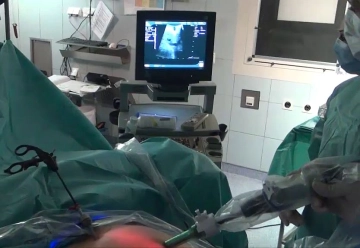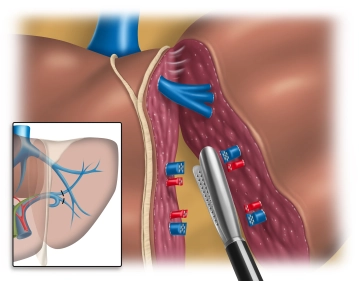Skin incision about two or three finger breadths superior to the umbilicus; insert the Verres needle and establish pneumoperitoneum with 13mmHg under pressure control. Insert a 10mm shielded trocar Insert the laparoscope and explore the upper quadrants: There is an inflamed conglomerate mass; at its superior aspect the left hepatic lobe adheres to the diaphragm, while its inferior aspect is caked with the stomach and greater omentum.
-
Establishing the pneumoperitoneum, inserting the trocar for laparoscope and exploring the upper quadrants
-
Inserting the working trocars, transecting the round and falciform ligaments of the liver
-
Freeing the liver
Inflammatory changes make it rather difficult to free the left hepatic lobe. This requires freeing the liver step by step from adhesions with the diaphragm until the left hepatic vein has been freed. Due to extensive adhesions it is impossible to identify the triangular ligament as such. Both the stomach and the lesser omentum also display extensive adhesions with the visceral aspect of the left hepatic lobe. Detach the stomach from the inferior aspect of the liver, free the hepatic hilum and open up the lesser omentum all the way to the diaphragm.
-
Local findings: Intraoperative ultrasonography (IOUS)
Exchange the 12 mm trocar in the left upper quadrant against a 15 mm trocar for insertion of the ultrasound probe. IOUS allows detection of additional tumor findings as well as assessment of the intrahepatic course of vessels. This permits inferences regarding resectability and assessment of the possible safety margin around the hepatic mass and therefore helps significantly in determining the resection margins. During the examination depicted in the video a thrombus is seen within a branch of the portal vein.
-
Starting parenchymal resection, transecting the portal vein and hepatic artery
Transect the parenchyma along the left margin of the falciform ligament from the anterior margin to where the left hepatic vein enters the inferior vena cava.
Note: To prevent injury to the pedicle (branch of the portal vein, hepatic artery and common hepatic duct) to segment IV, it is important to keep the line of transection on the left side of the ligament.
With a wide laparoscopic retractor (Endo Paddle Retract™, 12mm instrument, subxiphoid access) the tumor carrying lateral segments are retracted to the left. When transecting the parenchyma with the Ultracision, start with the parenchymal bridge between segments IV and III. For the basal hilar dissection of the segment staple the pedicle (angled stapler, blue cartridge).
Tip: To ensure sufficient coagulation close the Ultracision branches very slowly and without any force. Soft parenchyma lends itself quite well to transection with the water-jet dissector; its advantage is less aerosol formation compared with the Ultracision.
You are now advancing into the parenchyma and can successively dissect along the segment margins up
Activate now and continue learning straight away.
Single Access
Activation of this course for 3 days.
Most popular offer
webop - Savings Flex
Combine our learning modules flexibly and save up to 50%.
€44.50 / yearly payment
general and visceral surgery
Unlock all courses in this module.
€149.00 / yearly payment
... - Operations in general, visceral and transplant surgery, vascular surgery and thoracic surger
Activate now and continue learning straight away.
Single Access
Activation of this course for 3 days.
Most popular offer
webop - Savings Flex
Combine our learning modules flexibly and save up to 50%.
€44.50 / yearly payment
general and visceral surgery
Unlock all courses in this module.
€149.00 / yearly payment

